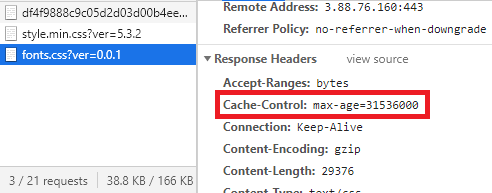

GetPlugin().DefaultMaxAge = TimeSpan.Zero The base setup is as follows Plugins.Add(new CorsFeature(allowedHeaders: "Content-Type, authorization, If-Unmodified-Since, If-Modified-Since")) Currently we are using If-Modified-Since headers to try and improve some performance of some endpoints. For example, the header Vary: Accept-Language, User-Agent specifies that a cached version must exist for each combination of user-agent and language.I’m hoping I’m just missing some setup. Vary – A header that determines the responses that must match a cached resource for it to be considered valid. If a token is unchanged before a request is made, the browser continues to use its local version. The expires header is ignored when a cache-control header containing a max-age directive is present.ĮTag – A response header that identifies the version of served content according to a token – a string of characters in quotes, e.g., “675af34563dc-tr34” – that changes after a resource is modified. For example, a web page response marked as private can be cached by a desktop browser, but not a content delivery network (CDN).Įxpires – This header specifies a fixed date/time for the expiration of a cached resource. The private response directive indicates that a resource is user specific-it can still be cached, but only on a client device. The public response directive indicates that a resource can be cached by any cache. This setting is usually used for sensitive data, such as personal banking details. The no-store directive means browsers aren’t allowed to cache a response and must pull it from the server each time it’s requested.

The no-cache directive means that a browser may cache a response, but must first submit a validation request to an origin server. After expiring, a browser must refresh its version of the resource by sending another request to a server. The max-age request directive defines, in seconds, the amount of time it takes for a cached copy of a resource to expire. The headers which can be used in the header field are: The Cache-Control HTTP/1.1 general-header field is used to specify directives for caching mechanisms in both requests and responses. Incomplete results: a 206 (Partial Content) response.Error responses: a 404 (Not Found) result page.Permanent redirects: a 301 (Moved Permanently) response.Successful results of a retrieval request: a 200 (OK) response to a GET request containing a resource like HTML documents, or other content available on the website.The primary cache key consists of the request method and target URI (oftentimes only the URI is used as only GET requests are caching targets). A private cache is dedicated to a single user. There are several kinds of caches: these can be grouped into two main categories:Ī shared cache is a cache that stores responses for reuse by more than one user. By making use of HTTP caching, Web sites become more responsive. Web caches reduce latency and network traffic as well as the time needed to display a representation of a resource. The performance of content that is available via web sites and applications can be significantly improved by reusing previously fetched resources.


 0 kommentar(er)
0 kommentar(er)
